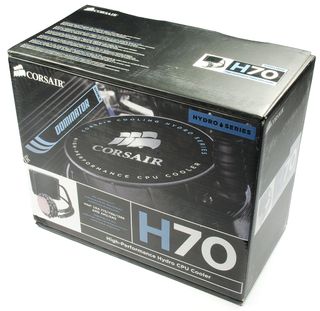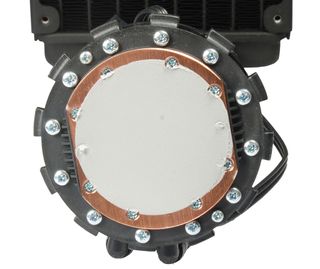Corsair H70: Next-Gen Self-Contained Liquid Cooling
Liquid cooling still has the image of being expensive and complicated. Corsair, in cooperation with the cooling specialists at Asetek, now offers the H70 that aims to simplify the step up from air cooling. Can it beat less expensive premium heatsinks?
Corsair H70: Design And Technical Data
Delivery

The Corsair H70 prefab liquid cooling system comes in a sturdy cardboard box. In addition to the already-filled, closed loop cooling system consisting of radiator, hoses, and water block with built-in pump, we find detailed installation instructions and mounting hardware for different computer platforms in the package. The Corsair H70 supports Intel's LGA 775, 1366, 1156 interfaces, along with AMD's AM2 and AM3 sockets.
Additionally, the Corsair H70 cooling system includes two fans that operate at 2000 RPM. The included adapter cables with embedded resistors (~30 ohms) can be used to bring the fans down to 1600 RPM for quieter operation. There is no thermal compound included, which most coolers usually do bundle.
Compact Water Block

Instead, Corsair opts to cover the CPU water block base with a layer of thermal compound straight from the factory. This thermal compound is protected by a solid and easily removable plastic cap that is attached to the underside of the water block, protecting it from damage during transport.
Hardcore cooling enthusiasts would likely remove the compound and replace it with a thin layer of something more expensive, but obviously this is not mandatory.
With a height of just two inches, the water block is very compact. The low profile is even more notable when you consider that the pump is integrated with the water block, driving the coolant through the closed loop system. A cable connects the pump and the motherboard, supplying the pump with 12 V power. The pump is extremely quiet; only in a completely silent environment were we able to hear a faint hum.
Stay on the Cutting Edge
Join the experts who read Tom's Hardware for the inside track on enthusiast PC tech news — and have for over 25 years. We'll send breaking news and in-depth reviews of CPUs, GPUs, AI, maker hardware and more straight to your inbox.
Rigid Tubing
The coolant travels through the cooling system via two small and relatively rigid tubes. They have an outer diameter of about 8 mm and a length of about 24 cm. The tubes are attached to the pipes in such a secure way that they can only be replaced with great effort. Except for the water block, the loop also includes the radiator. Due to the short length of the cables, you might not be able to install the radiator exactly wherever you want to if you are using a large computer case.

Current page: Corsair H70: Design And Technical Data
Prev Page Liquid Cooling For The Mainstream Next Page Mounting The Radiator And Fan-
wribbs "street price of around $110, it is reasonably priced" -too high.Reply
"slightly elevated background noise" -understatement
You will be better served by the h50, yes its weaker but its cheaper and quieter and performs close to the same. Do yourself a favor and avoid this product although it is quite good.
-
karma831 Overpriced, equal to or gets beat by air cooling in temps, and is pretty loud...Doesn't sound like a very good product ?__?Reply
The prolimatech and noctua offerings are much better. -
maxal Would it be possible to post combined charts of idle temp/noise and full load temp/noise ? IMHO that would be more informative than plain bars, as many are interested in balance of those characteristics.Reply
-
gkay09 I had expected to see even the CM Hyper 212+ results...Reply
IMO $110 for such a cooler not worth it,...Other good option if going for a closed loop cooler would be the CoolIT SYSTEMS ECO... -
cmcghee358 I would have also liked to have seen comparison between a push/pull exhaust, and a push/pull intake.Reply
For my H50, it is quite explicit that the radiator should be pulling outside air through the fins. And yet, people keep it as an exhaust and then lament of their temps.
One of the biggest perks of a closed loop water cooling system is you dictate what air is being used. Where-as big air is always restricted to case air(unless a side is removed and a box fan is added)
I would have also liked to of seen it as a delta above ambient, rather than a flat CPU temperature comparison. I personally process the delta better, and lend more credence to it. -
uruquiora would have liked to see the temps in passive mode, with no fans, and on a more recent CPU...Reply -
mjello I want one for my gfx card not the cpu. Its my gfx thats noisy. I don't care about cooling temps or overclocking as long as the cooling is adequate. I just want sweet silence :).Reply -
cmcghee358 Reply9503478 said:I want one for my gfx card not the cpu. Its my gfx thats noisy. I don't care about cooling temps or overclocking as long as the cooling is adequate. I just want sweet silence :).
I guess you missed the part where it was the noisiest thing on the list with a 57.3 dB at max?
Also considering the TDP of some of these GPUs are between 190 and 300W, you can expect the H70 to work much harder thant he sample 130W CPU. So it will most likely be loud all the time because of the higher operating temps of the GPU.
Most Popular


